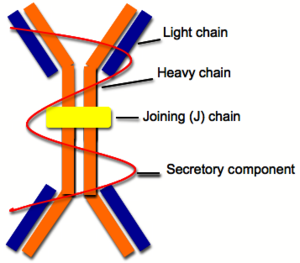IgA
IgA antibodies are also called the mucosa antibodies, because they are produced by B - Lymphocytes located in the mucosa layers. The concentration of IgA antibodies in the serum is only 1.5 g/l, but even so are IgA antibodies the most numerous antibodies in our body. Their halftime is one week.
- Structure
IgA antibodies have similar structure as IgG antibodies. Their molecule consist of two light chains and two heavy chains. Each light chain consist of one constant domain and one variable domain. Heavy chains consist of three constant domains and one variable domain. In contrast to IgG, IgA antibodies may exist as monomers, but even so they mostly occur as dimers, which are linked by a J-chain. For example, in the serum, IgA antibodies occur almost always as dimers. What is interesting about IgA dimer structure, is that when they are being secreted at the surface of mucosa, the connection between the two parts of dimer is enhanced by the presence of a protein structure called the secretory component. This protein structure protects the IgA dimers against the chemical break down by enzymes.
- Funkcion
- Blockage of adhesive molecules - they react with the adhesive molecules of bacteria.
- Opsonization - they bind to a specific Fc-α-receptors of phagocytes.
IgA antibodies are not able to activate the complement system.
Links[edit | edit source]
Related articles[edit | edit source]
Used literature[edit | edit source]
- HOŘEJŠÍ, Václav a Jiřina BARTŮŇKOVÁ. Základy imunologie. 3. edition. Prague: Triton, 2008. ISBN 80-7254-686-4.
Category: Immunology

